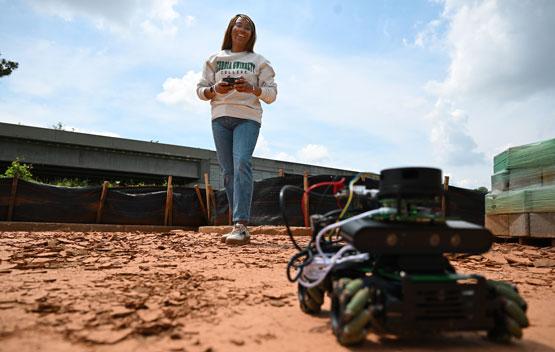news
Space: The final frontier
At least for now, only a select few have the chance to travel to space and explore. At Georgia Gwinnett College (GGC), a team of students designed Dynamic Objective Reaching Autonomous Rovers (DORA), which may someday be useful in surveying the moon’s landscape. DORA, along with its two, small swarm rovers, can collect information about the moon’s physical features, landmarks and environmental conditions autonomously. The data collected can then be used to help create detailed maps of the lunar surface, which saves the astronauts’ time and resources.

It’s all part of the NASA Minority University Research and Education Project Innovative New Designs for Space program, more commonly called NASA MINDS.
A team of five GGC students, senior Ewura Ama Awere, sophomores Shone Cherian and Jennifer Jimenez-Hernandez, and freshmen Tamera Crawford and Anthony Damian, collaborated on DORA. This year, DORA was not only accepted and funded by NASA MINDS, but it also opened the door for the students to be interviewed by NASA.
“Being interviewed by NASA felt like a full-circle moment. I couldn’t help but reflect on our first NASA MINDS experience and how far we had come since then. It was incredibly validating and meaningful to share the progress we made. I saw the interview as a moment of closure and growth,” said Cherian, who's majoring in information technology (IT) with a concentration in systems and cybersecurity, and a second-year participant in NASA MINDS.
“We spent a lot of time preparing once we were notified as finalists, and I was proud of how well we organized our presentation to showcase our best work,” said Awere, an IT major with a concentration in software development. “After our final presentation, the NASA judges and subject matter experts gave encouraging feedback and thoughtful suggestions for future development. I’m grateful our hard work led to that opportunity, and I hope we’ll continue learning from these supporters to improve our process, research and impact in this field.”
For Damian, the experience was inspiring.
“As a team made up of aspiring engineers, mathematicians, and programmers, we knew how sacred NASA was to the world of STEM,” he said. “For me, I wasn’t just being interviewed by NASA, I was being interviewed by engineers and scientists who were once in my same shoes, engineers and scientists who were once only students looking up to their inspirations.”
The process of being accepted is rigorous.
“The application is quite involved. It requires not only a budget and a second, detailed application, but also a preliminary design review that was over 20 pages, and a systems engineering paper that was nearly 30 pages,” said Dr. Sairam Tangirala, professor of physics.
GGC’s team competed against other colleges and universities nationwide and earned second place in the poster category for DORA. At GGC, the team also won Best Poster in the Physics, Math, Computer Science, Engineering & Technology Category at the 2025 Georgia Academy of Science Conference for their project, “Mapping the Moon’s Surface using Project DORA: Dynamic Objective-Reaching Autonomous Rovers.”
DORA’s capabilities and recognition is one thing but naming her came from team members’ shared childhood memories.
“The name DORA was Shone’s brilliant idea, which perfectly tied into our project’s goals. While brainstorming for our autonomous lunar rover system, he drew a clever parallel to Dora the Explorer – the adventurous, problem-solving icon from our childhoods,” said Awere. “DORA became the name for our lead rover, responsible for data processing and mission direction, while the agile support rovers were dubbed Boots 1 and Boots 2.”
In Dora the Explorer, Boots is Dora’s best friend.
GGC’s participation in NASA MINDS began in 2019 said Tangirala, who, along with Dr. Tae Song Lee, associate professor of physics, mentored the team.
“It all started as a STEM outreach opportunity for our students,” Tangirala said. “Our students are in the applied physics lab, which incorporates engineering aspects.”
The purpose of participating not only gives students the experience, but also opportunities.
“This is a chance for our students to showcase their work beyond the classroom and the opportunity to earn internships and even jobs with NASA,” said Tangirala.
Throughout the experience, both Awere and Cherian gained knowledge and experience that reached beyond the project itself.
“One of the most rewarding aspects of working on this project has been stepping beyond software and engaging with hardware and electronics. Robotics is inherently multidisciplinary, and this project required me to work across areas like electronics, mechanical design, and programming,” said Cherian. “It also opened my eyes to how accessible robotics has become thanks to tools like ROS 2 (Robot Operating System 2).”
“This project gave me real-world experience in project management, goal-oriented communication and leadership that I’ll carry into future roles. Helping lead a two-semester project with teammates from diverse academic backgrounds, research experience levels and schedules was challenging – but deeply rewarding,” said Awere.
View and download NASA MINDS gallery photos and b-roll.
